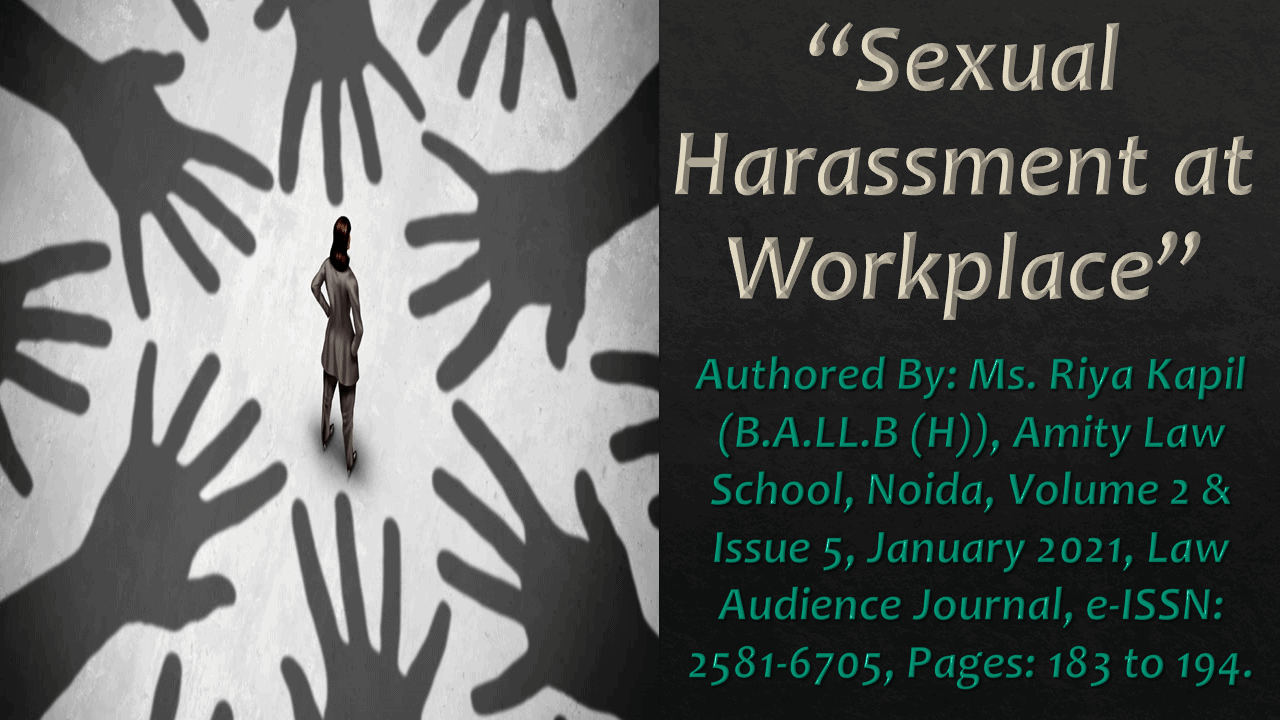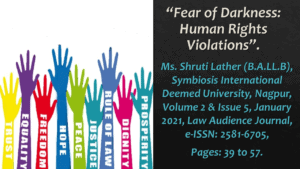Click here to download the full paper (PDF)
Authored By: Ms. Riya Kapil (B.A.LL.B (H)), Amity Law School, Noida,
Click here for Copyright Policy.
Click here for Disclaimer.
I. INTRODUCTION: WHAT IS SEXUAL HARASSMENT AT WORKPLACE?
Sexual harassment is a kind of sexual behaviour which is not pleasant and which is unwelcome. That sexual behaviour by which a person gets offended, humiliated. This behaviour can be physical, verbal or in a written form. It’s a kind of behaviour in which there is no mutual consent.
It is said to be sexual harassment in workplaces when this harassment happens:
- At the working place of a female worker.
- At any area which is related to or event.
- Or between the people who are sharing the same workplace.
For constituting sexual harassment repeated behaviour is not required. A Single incident of unwelcome sexual behaviour is enough. Not responding at the time of inappropriate behaviour, doesn’t mean that a person is consenting to an inappropriate behaviour. No matter what profession it is, a woman faces such problems everywhere in the world. But it seems that the legal system sleeping and fails in providing them security. Somewhere, it shows the mental tendency of a man because if he harasses a woman at a workplace this shows that he wants himself as a dominating personality and in his own comparison he thinks that women are weaker than man. We can see that one out of every third complaint which is registered by women, they are touched with the intention of sexual harassment. Not only India but every country is facing this problem today. The sense of security is lacking and every female worker is unsafe. We can see that the behaviour of sexually harassing women is rooted in cultural practice. There is a need for enough emphasis on workplace sensitisation. For protecting women there are certain developments which are made in the law.
II. THE LAWS FOR SEXUAL HARASSMENT AT WORKPLACE:
If we see the laws which are present in India, the fundamental rights of a woman which are given by the constitution of India they get violated by any kind of sexual harassment. In 2013 Act (Sexual Harassment of Women at Workplace (Prevention, Prohibition and Redressal) Act, 2013) was passed by the legislative body to preventing sexual harassment of a female worker at the workplace. The Act ensures that women are protected against sexual harassment at all the workplaces whether it’s private or else public. It is a matter of gender equality as well as their liberty and life. Women also need equality in working conditions. This Act gives the sense equality to women which will be helpful in many ways like if a place is safe and secure then more women will participate and obviously this is going to affect the growth and economy of a country. The laws and Act were derived from the Vishaka Guidelines. These are the certain guidelines, to be followed in cases of sexual abuse in workplaces. The guidelines were formulated after the landmark case “Vishaka and Others vs. State of Rajasthan[1]”.
III. CASE LAWS:
There are varied case laws in India that had preceded the courts and largely their judgement has encouraged and strengthen the women so that they can register more and more complaints in comparison to earlier conditions.
III.I Apparel Export Council vs. A.K. Chopra[2]:
In this mentioned case the supreme court said that molestation against ladies is discrimination of the basis of gender and conjointly aforesaid that if any superior authority tries or act to molest his women employee then it will represent molestation.
III.II Vishaka and Others vs. State of Rajasthan[3]:
This case was dropped at the Supreme Court as a result of court was unable to supply justice to Bhanwari Hindu deity she was a district women’s development program of Rajasthan government. She was viciously gang raped as she was stopping a toddler wedding that was being conducted in a very city. As a member of development program this was a district of her duty to prevent any criminal activity conducted against youngsters and girls. The court determined that “for the aim of interpretation of the guarantee of gender equality, right to figure with human dignity in article 14, 15, 19(1)(g) and 21 of the constitution[4] and safeguards against the molestation implicit in this, the international conventions and norms ought to be thought-about”. Supreme Court of India outlined what precisely is molestation and set the rules for the leader.
IV. POST VISHAKA DEVELOPMENTS:
Following the vishaka judgement, there were other amendments also which prohibits molestation of operating lady. The Supreme Court in the case of “apparel export council v. A.k Chopra”.[5] During the case, the Supreme Court stressed on guidelines and the law which was made after the judgement of the vishaka case and dismissed the superior officer of the promotion council because he was caught guilty because he was sexually harassing his junior female worker. The Supreme Court enlarged the definition of molestation during this case, by ruling that to creating to associate act of molestation physical contact wasn’t essential for it.
The supreme court in its judgment in “Medha Kotwal Lelle and Others vs. Union of India and Others”[6]. The court directed that for ensuring the vishaka guidelines are being implemented properly or not it directed the state that it can put sufficient mechanism if it is not satisfied. In case if the guidelines are not followed whether it is done intentionally or unintentionally, finally the Supreme Court asserted that, the aggrieved person can approach to the high court in such matters. The supreme court also said that the complaint committees which were formed after the guidelines of the vishaka case have the power of enquiry committee and also the report given by the complaints committee is going associate in nursing inquiry report.
V. FAILURE IN IMPLEMENTING THE LAWS:
After the vishaka guidelines were implemented, it became compulsory to constitute a complaint committee at every workplace so that women can easily approach to that committee but still there are a lot of private companies who failed to do so while the government organisations also do it on paper basis. The organisations where such committees exist, there are some other problems and the victims have reported that even committee members do not take their responsibilities, powers and duties seriously. So, there is lack of seriousness which very rarely leads the victim to get justice.
VI. #METOOINDIA: SEXUAL HARASSMENT REPORTED AT WORKPLACE:
According to official data of Mumbai, between 2014 and 2017 the cases which were registered in India were increased to fifty-four percent. If we see the government’s data then in 2017 and 2018, there were more than two thousand such cases of sexual harassment which were registered and in the mid of the year 2018 the data says that nearly every day there were two cases of sexual harassment which were reported.
According to this data, in the ending of July 2017, and during the first 7 to 8 months of 2018, the cases of sexual harassment Which were reported in the whole country were more than five hundred.[7] Me too movement was started in united states there were charges of rapes and molestations and after one year India has its own #METOO movement.
By this movement, women get inspired by one another by sharing their personal stories of harassment and also it helped them to gain courage and strength to speak up or raise voice against the sexual harassment. In 2018, a model and also a Bollywood actress, was one who alleged Nana Patekar that he sexually harassed her while they were shooting for a movie, he did this on the sets. She filed a police complaint against Nana Patekar, the producer, choreographer and the director of a film. They all were doing the same film “HORN OK PLEASE”. Against other prominent personalities from various industries also there have been allegations of harassment like cinema, media, music and entertainment[8].
VII. CASES REPORTED IN UP AND DELHI:
The records and the data which is present in Lok Sabha according to that most of the cases were reported in Uttar Pradesh between the time period of 2014 to 2017 and there were other states also like Delhi, Haryana, Maharashtra, Madhya Pradesh etc. Section 354A IPC “deals with the offended of sexual harassment including physical contact, unwelcome sexual behaviour, demand or request for sexual favours, showing pornography to a woman against her will”.[9] In another set of data “insult to the modesty of women” under section 509of the IPC[10], the “national crime records bureau” (NCRB) categorises that Workplace harassment is included in this. In 2016, NCRB reported 665 such cases.[11] Even speaking a single word or sound, any gesture or any act which is committed with the intention of insulting a woman could be an offence.
VIII. IMPACT ON WOMEN:
It is a sad reality that in India the majority of women have been either harassed, abused or known someone who has been a victim and yet there is a taboo and silence attached to the subject. In the kind of society, we are living in it takes a lot of strength, to speak up about issue or abuse they face and also when women speak about any such issue, she is subjected to victim shaming, societal pressure, abuse, intimidation, character assassination etc. India as a society is highly obsessed with protecting its ‘culture’. A woman, apart from being responsible for her own ‘dignity’, she is also responsible for protecting the honour of her family. Hence, she is expected to keep silent on anything that violates her sanctity of being a woman. Also, the fear of being expelled discourages women to name their abusers, lack of support is on the top of that. It could be triggering for the survivor that after an assault often they face psychological trauma and when the accusers are respected and celebrated in the society. Sometimes women were boycotted for speaking out and were tagged as ‘trouble-makers’. Although this was one of the movements which helped the women by giving them strength to speak up against such activities and the patriarchal mind-set of our society and also helped in women empowerment.
IX. WHY WOMAN ARE AFRAID TO SPEAK:
More than seventy percent of the women have said that they did not speak up or complain about sexual harassment because they feared about the outcomes and the results of raising their voice, “according to the survey which was conducted by the Indian bar association in 2017, of 6,047 respondents[12]”. There is low or no reporting in such cases because women have the feeling no one will listen to them because there are lot of pending cases which have not been dealt sincerely and also women are not aware about the things, they can do like they do not know where they can go to report such complaints. Often, believing committee to be independent women go to report to them but they find that there is no one to listen what is happening at the workplace and they are only puppets who are working under the superior authority. But with time, women are raising their voices against the sexual harassment and the ratio has increased and grown higher. Also, there are number of cases which were filed against the sportsperson or against the sports authority. “The minister of state ministry of youth affairs, Rajya Vardhan Rathore, informed to the Lok Sabha in his reply on 19 July, 2018. However, during the time period in which the cases were registered was not mentioned.”[13]
With the objective of secure work and safe working atmosphere in the both “organised and unorganised sector”, the central government has enacted the Act. “The Act provides security to ‘aggrieved woman’ in which the women employed by the organisation are included as well as the women who are associated with the organisation such as a visitor or an intern”.
IX.I Against whom a female employee can complain?
Against the employee of the organisation a complaint can be filed, or even an outsider who is coming in a workplace in relation to any work, such as a vendor, consultant etc. The government dedicated a portal for redress that is ‘SHE-BOX’, so that women will speak against the harassment at workplace and report it to the government.
X. WHY SHE BOX WAS INTRODUCED?
The sexual harassment electronic box (SHE-BOX). “This was initiated by the government of India to provide security to female workers, the aim of SHE-BOX was that any female worker facing such problem can complain by accessing a single window whether she works in a private, public, organised or unorganised sector or irrespective of her work status, she can register a complaint related to sexual harassment through this portal”. Any female worker who is facing this problem of sexual harassment can make her complaint and submit it to the SHE-BOX portal, the complaint of that portal will pass on to the authority in power, means who have the jurisdiction of taking action in those matters.
XI. PROCEDURE FOR REGISTERING A COMPLAINT OF SEXUAL HARASSMENT:
It is very easy to file a complaint in ‘SHE-BOX’. All you need is a valid email id through which a complaint is being registered. Anyone who wants to make a complaint can follow these steps:
- Start with clicking on a complaint register tab.
- Then you need to fill up the information about the workplace where you faced the sexual harassment like whether your office is government or a private one.
- Then you will see a complaint registration form on your computer screen.
- Then you need to fill up all the details which are necessary for registering a complaint after that by clicking on a “submit tab” you can submit your complaint.
- After all this process the person will get a confirmation on the email id which was provided during the complaint registration.
XII. DEALING WITH SEXUAL HARASSMENT IN THE VIRTUAL WORKPLACE:
During this current lockdown, now work from home is an accepted part of corporate life. While there are lots of issues such as data privacy and cyber security dimensions of safety and workplace security is equally important. The POSH Act makes it very clear that it includes both organised and unorganised sectors, any work related offsite, office party as social media groups or any place which comes under the ambit of work-related relationship. The complex scenario is that if we give broad boundaries to this definition, it becomes worth to think about virtual world of video conferencing and the manner in which this Act becomes applicable. During this outbreak of COVID-19, one of the reports says that 91 per cent of HR leaders have implemented work from home[14].
Employers should take all the steps to ensure that this virtual workplace remains safe and free from intentional or unintentional harassment. While on social media on daily basis, there are a lot of memes and jokes about the workplace attire, HR leaders must emphasis on the point that same rules of professional decorum should apply, irrespective of whether there is a meeting in a physical space or on a virtual platform.
While attending the video conferences, dress code needs to be maintained by the employees. Employee needs to be dress up properly, on the video conference they must not dress in vests or undergarments also some other aspects need to be checked such as during the virtual meeting, there should not be any poster on the wall with provocative content or which can cause discomfort to anyone. These are some examples which emphasis on a key message of the POSH Act that harassment could be any conduct which is unwelcome and sexual in nature or the one where impact matters not the intent.
Sensitisation and proper training are important. Mangers must not insist their female colleagues to log on to one-on-one video call, if they have the option to take calls in ‘audio-only’ mode. With the mandatory POSH training not only the topics like appropriate dressing and keeping the conversation limited to work should be included but also the things which needs to be ensured are that in the context of a video call, employees must fully understand what is appropriate and what is not.
XIII. IMPACT AND CONSEQUENCES OF SEXUAL HARASSMENT:
While it is being difficult to find remedies against increasing cases of sexual harassment nobody could deny the overall effects it causes on productivity and work atmosphere of any organisation. In unorganised sectors also, there are innumerable incidents of sexual harassment. The way it is growing it is becoming toxic for the whole society and had its effect on the whole organisation; it has its multiple impacts on women who faces such problems and on the organisation as a whole. Whenever a case of sexual harassment took place it makes the life of that working women so much distressing and miserable, she would seek redress which are given under the laws such as “section 354 (outraging of modesty), 509 (insulting of modesty) of IPC”.
If we look from a wider scope of Human Resources, sexual harassment causes so many effects such as
- Somewhere these women start blaming themselves, they develop a feeling of guilt.
- They become insomniac or develop other kinds of sleeping problems.
- Sexual harassment leads to depression.
- Anxiety, fear and their interest in work also decrease.
- Uncertainty about the future and also, they become restless.
- Such harassment can also lead to physical or emotional attacks like they withdraw themselves from their family, friends and co-workers etc.
Therefore, it is the employer’s duty to provide such a working environment in which every worker should be treated with dignity.
XIV. PREVENTIVE MEASURES TO CHECK SEXUAL HARASSMENT:
The basic requirement for implementing anything in the society is the change in attitude of people. If we implement some laws, then it will lead to protect and safeguard women against these toxic activities of unwelcome sexual behaviour. For restricting such harassments and to provide every female worker a safe and secure working atmosphere prevention should be done at the ground level all the employees should understand their responsibility to make women feel safe.
There are some steps which need to be followed for preventing sexual harassment at the workplace:
- For direct communication with the women employee, there should be a proper communication channel through which complaints could be heard directly. The women should not feel any kind of doubt and insecurity while she is raising her voice about the problems she is facing at the workplace during the course of her employment. It is a responsibility of a complaint committee to listen such problems carefully and take appropriate actions immediately without wasting much time.
- Women worker should speak up about the things they are facing they should not fear about anything; they need to tell all the things which are happening with them so that the authorities should take care of such behaviour.
- If a woman is complaining then it becomes mandatory to keep it confidential and becomes the responsibility of complaint committee to assure their employees regarding such matters.
- For both males and females there should be sexual harassment awareness training, conducted by every organisation. If they learn all these things mutually then it will help in making the working atmosphere friendly as well as employees will feel safe and comfortable. Impact of sexual harassment in women should be included as a part of training.
- Every employee needs to understand that it is his duty and responsibility to provide every female worker a sense of security and positive atmosphere in workplace.
- The employer should understand that any kind of harassment on his female employee will have its direct effects on her health, she can lose her confidence and her working potential will also decrease due to which she will leave her job.
- In spite of degrading a woman she should be motivated so that she will feel free to complain about her problem which is harming her in many ways employer should check that for speaking up against the harassment she should not face any kind of fear and taunting at the workplace.
- Complaint committee should not be biased towards a particular person the treatment should be equal for every person who is working. For example, on the basis of seniority or position at a workplace no privileges should be given to them. They must opt equal treatment and punishment for all.
XV. CONCLUSION:
I firmly believe that all the women must raise their voice, especially who all are the victims of sexual harassment. Every woman should immediately complain at the time of the occurrence of such incident she should not fear about anything. And if she feels her complaint is not being registered or not even being fairly addressed then she should resort to other alternatives which are available because not talking about something is not a solution.
So, if a woman needs justice, she needs to raise her voice. Even with some loopholes, somewhere the Act has helped in creating safe and healthy environment for women. The employers also helped us by enacting policies and by following the guidelines of sexual harassment Act for their organisation which has brought a tremendous change for the women at their workplaces.
The implementation of this Act has reduced the harassment of women at workplaces but still there are many challenges and it will not be easy to cope up with these challenges but as we Indians have democracy in our country, government cannot ignore what citizens are demanding form a long time and gradually, the law will take its course.
Well, it is not only the government’s duty or an employer’s duty to provide a secure environment but also it is a duty of every single worker in workplace to create and maintain positive and safe environment at the workplace so that no women have fear while working in any sector and she can enjoy her freedom and live her dream like any other man at that workplace. Every woman should stay strong and entire county should stand by them in giving women the strength, to raise their voice so that all the wrongdoers will be duly punished.
References List:
- https://www.equalityhumanrights.com/en/sexual-harassment-workplace.
- https://www.humanrightscommission.vic.gov.au/the-workplace/sexual- harassment-at-work.
- https://www.indiaspend.com/metooindia-54-rise-in-sexual-harassment- reported-at-workplaces-between-2014-17/.
- http://www.legalservicesindia.com/article/716/Sexual-Harassment-at- Workplace.html.
- https://en.m.wikipedia.org/wiki/Me_Too_movement_(India).
- Sexual Harassment of Women at Workplace (Prevention, Prohibition, Redress) Act, 2013.
[1] AIR 1997 SC 3011.
[2] AIR 1999 SC 625.
[3] supra note 1.
[4] Constitution of India.
[5] supra note 2.
[6] 2013 1 SCC 297.
[7] https://www.pressreader.com/india/the-new-indian-express/20181016/282162177181975.
[8] Abhery Roy, 2018: The Year When #MeToo Shook India, available at https://economictimes.indiatimes.com/magazines/panache/2018-the-year-when-metoo-shook-india/2018-the-year-of-metoo-in-india/slideshow/66346583.cms.
[9] Sec 354A, Indian penal code, 1860.
[10] Sec 509, Indian penal code, 1860.
[11] https://www.indiaspend.com/metooindia-54-rise-in-sexual-harassment-reported-at-workplaces-between-2014-17/.
[12] Sexual Harassment at Workplace: 69% Victims Did Not Complain to Management, Says Survey, available at https://www.firstpost.com/india/sexual-harassment-at-workplace-69-victims-did-not-complain-to-management-says-survey-3189524.html.
[13] Cyber Crimes against Women in India – Google Books Result.
[14] Gartner, Coronavirus in Mind: Make Remote Work Successful!, available at https://www.riverbed.com/blogs/15-surprising-stats-on-remote-work-due-to-covid-19.html#_edn1.



